Education

This education page has been especially designed as an aid to teaching people about butterflies. There is also a Fact sheet available for download. Butterflies are invertebrates which have some special features. They have three parts to their body and three pairs of legs (although some have only two pairs).
The head has the sensory organs like the antennae and eyes, the head also has the mouthparts on it, different insects have different mouthparts depending on what type of food they eat.
The thorax (the thorax is the part of the body with all the muscles). This part of the body has the wings which are used for flying and the legs used for walking.
The abdomen is the part of the body that has all of the bits that keep the butterfly alive like the guts and other organs.
Moths and butterflies are both from the insect order Lepidoptera (Meaning Scaled wings) but the number of moth species is far greater than the number of butterfly species.
Butterflies and moths all start life looking very different. They begin life as caterpillars (larvae) which are basically just eating machines. The most important job for caterpillars is to eat and grow. Whereas butterflies and moths need to spend their time finding a mate.
Why
do we need to conserve the natural environment?
In recent times it has become increasingly apparent that the
environment
in which we live is unable to cope with the stresses of modern day
industry
and human activity. The huge increase in the human population has lead
to higher demand on the earth as a resource and has lead to some
disastrous
consequences. Pollution, urban development, intensive
agricultural
practices have all lead to the ruin of the natural environment.
It is important to protect the world around us because it is where we get food and water from, wood and materials for housing and medicines. All living things rely on the natural environment, for the essential items needed to sustain life. If you take away an animals home and food source it will die. If a plant has to take in polluted water it will not be healthy and will not be a good food source for other animals.
Why
do things become extinct?
There are a number of reasons why plants and animals become extinct.
One of the major reasons for extinction is habitat destruction. A
habitat
is where something lives for example a fishes' habitat is a pond, a
leopards
habitat is the bush. If you take away a living things home, where it
sleeps
and finds food, it will die.
Habitats can be destroyed for all sorts of reasons.
* Development, building houses, other
buildings and roads.
* Agriculture, farming cattle and crops.
* Pollution, poisoning plants, rivers and soil.
Why
should we conserve invertebrates?
Invertebrates are important, they do lots of things that we could not
do without. They pollinate plants and some produce honey. Lots of
commercial
crop plantations rely on insect pollination. If insects didn't
pollinate
crop plants, there would be no seeds for the following year and
therefore
no crop and no food for us. Some invertebrates look after the soil,
they
make sure that there is enough air and that any waste material is made
into more soil. They tidy up, getting rid of leaf litter and other dead
animals. In some countries insects and other invertebrates are used as
food and are a major part of peoples diet.
Why
do we have butterfly farms (and zoos)?
Butterfly farms are not only very nice places to visit and see lots
of beautiful butterflies they also serve several important purposes. a
visit to a butterfly farm can teach you all about insects and other
different
animals and about different places in the world. It also a good way to
show people what it is like in a forest. Not very many people get the
chance
to visit a forest in their life time so we create miniature forests in
butterfly farms to teach people why we should look after them. Our
forests
are very special places. If we look at the rain forests, there are 3
major
rain forest regions in the world and they are found around the equator
where it is very hot. It rains a lot in these types of forest so the
weather
is humid (hot and wet). Rain forests do not cover a great deal of the
earth's
surface but are thought to the hold about 90-95% of the total world
species.
It is because of this fact that we must prevent them from being
destroyed.
Breeding is another of the uses for butterfly farms. These are lots of
people that think butterflies are very beautiful and like to collect
them.
To stop these people taking butterflies from the wild we breed
butterflies
especially for collectors and other butterfly farm displays.
Butterflies are not only threatened in other parts of the world, there are butterflies in South Africa that are under threat of extinction because of habitat loss and collection. You can do your bit to help by planting a butterfly garden either at home or at school.
Animals which start life looking completely different to their parents have complete life cycles or complete metamorphosis because they completely change their body form. Metamorphosis simply means a change in body form or size.
Butterflies are insects which have complete metamorphosis because they start life as an egg out of which hatches a larvae. Butterfly larvae are called caterpillars and do not resemble their parents at all. They have to completely change their body shape between the larval and adult stages. This is called the pupal stage, the caterpillar sheds its skin and forms a pupa. In the case of butterflies and moths this is also known as a chrysalis. Certain species of moth form an extra layer of protection around the pupa called a cocoon. This is produced by the moth caterpillar before it changes into a pupa, and is made from silk - modified caterpillar saliva. Butterfly caterpillars NEVER produce a cocoon, instead they ‘glue’ themselves to a branch using a small pad of silk, before their transformation into the pupa.
Inside the pupa, dramatic changes take place. The body of the caterpillar breaks down into the constituency of lumpy custard and clusters of cells regroup and reform the various parts that will make up the adult bodyparts.
Eventually, the adult is ready to emerge, it breaks free of the pupal skin, expands its wings and is ready to find a mate to complete the life cycle.
Other insects which undergo this
amazing transformation of complete
metamorphosis include beetles, ants, bees, wasps, flies and fleas.
Download Fact Sheet
 |
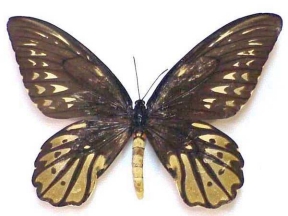 |
| Queen Alexander's Birdwing - Male |
Queen Alexander's Birdwing - Female |
The smallest butterfly is the "Western Pygmy Blue" (Brephidium exilis) with a wingspan of only 5mm, and is found in the U.S.A.
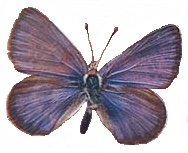 |
| Western
Pygmy Blue (Brephidium exilis) |
The largest African butterfly is the "African Giant Swallowtail" (Papilio antimachus), which is found in central Africa. It has a wingspan of up to 23 cm.
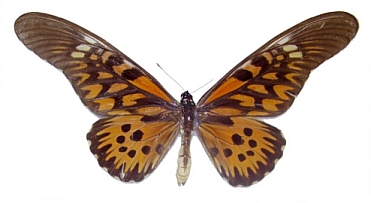 |
| Papilio antimachus (African Giant Swallowtail) |
The largest Southern African butterfly is the "Emperor Swallowtail" (Papilio ophidicephalus). The wingspan of this butterfly is approximately 14 cm.
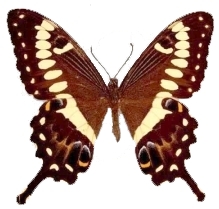 |
|
Papilio
ophidicephalus
(Emperor Swallowtail) |
Butterflies are easy to see when they fly around because of their highly colored wings. When they sit still they hold their wings vertically, hiding the distinctive patterns and showing only the dull undersides. This camouflages the insect from hungry predators. See example of Junonia natalica natalica below.
 |
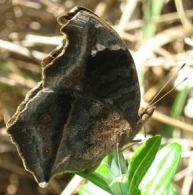 |
| Junonia natalica
natalica - Top |
Junonia natalica natalica - Bottom |
Butterflies and Moths belong to the order "Lepidoptera", which means "Scaly Wings". If you happen to touch a butterfly or moth's wings, your fingers will become covered with a fine dust. This fine dust is made of the tiny, overlapping scales that cover the insects wings. These scales produce the intricate and often brilliant markings for which the butterflies are known.
By far the most important sense for butterflies is smell. The sensors of their antennae are highly attuned to odours. Butterflies can also taste. Butterflies taste plants to identify them by using sensory structures on their feet.
The only continent on which there are no butterflies or moths is Antarctica.
From hatching to pupation a butterfly larva increases its body size more than 30 000 times.